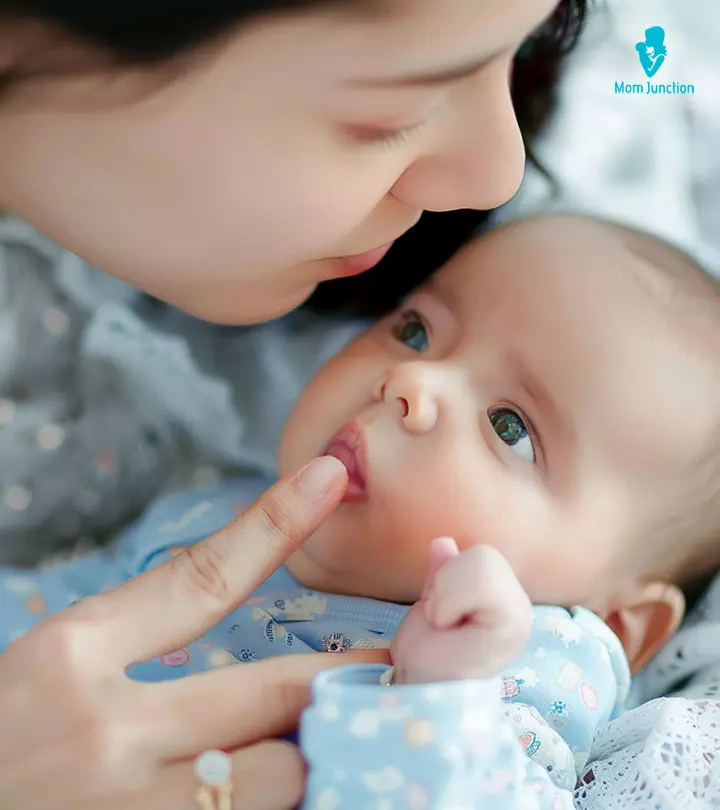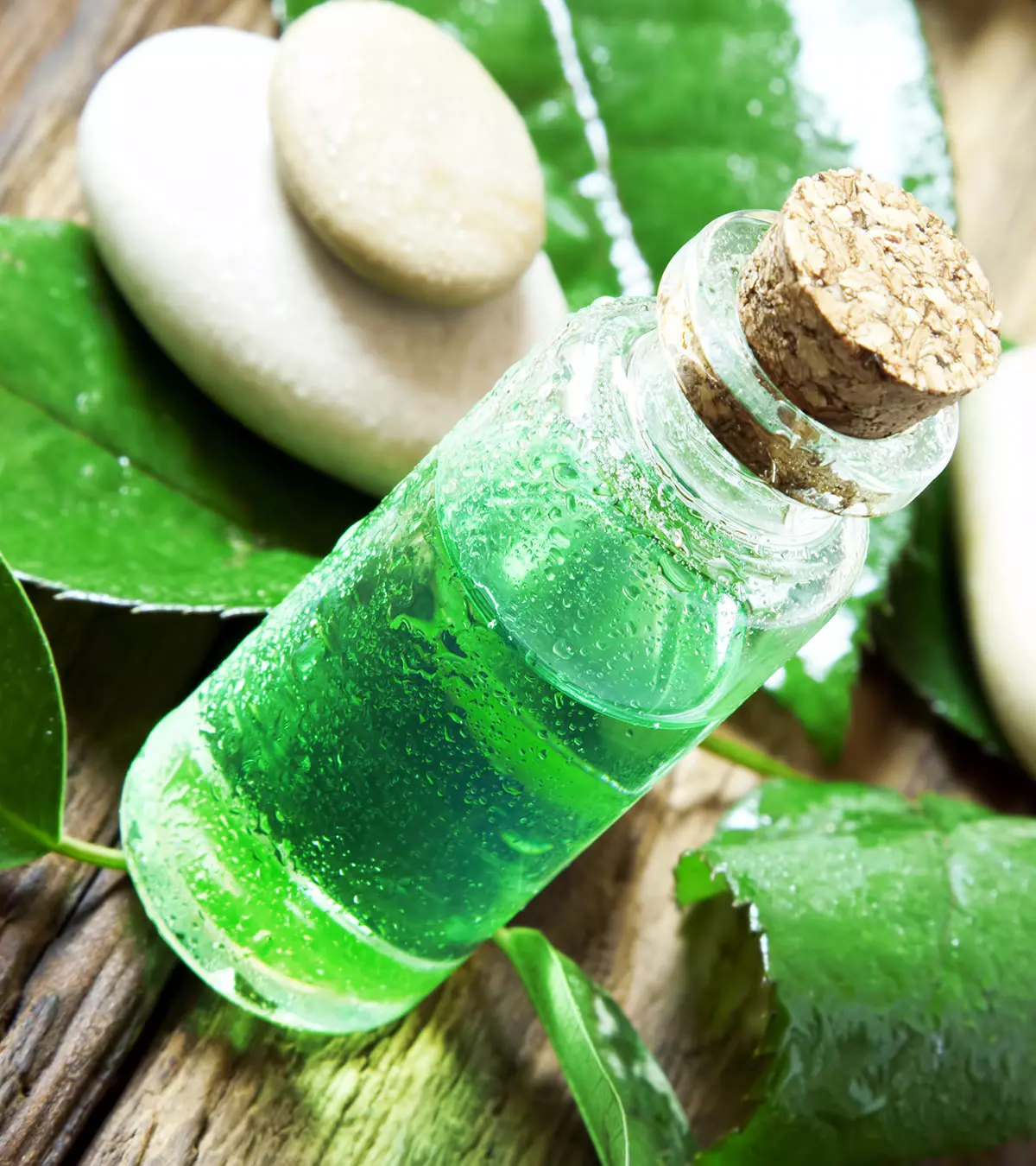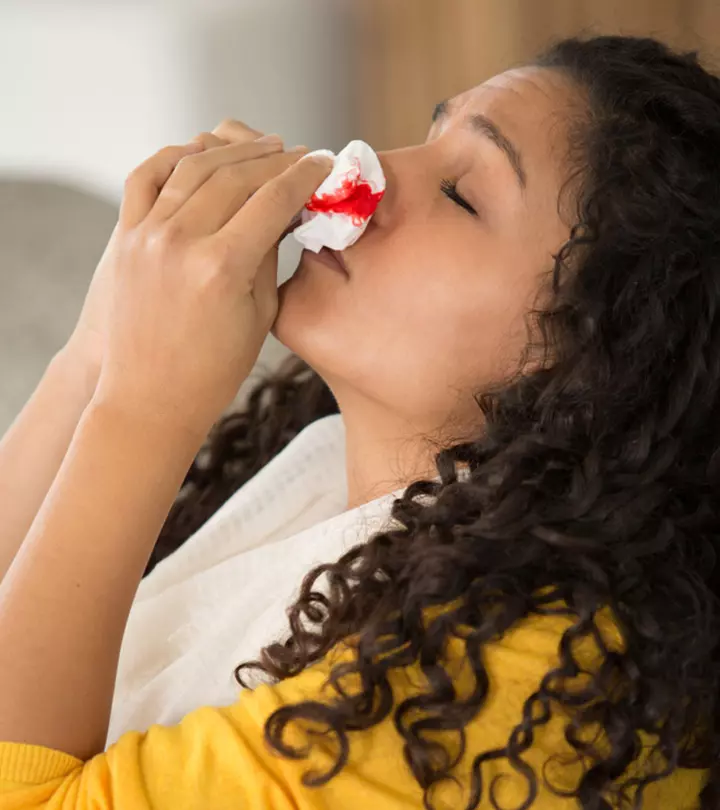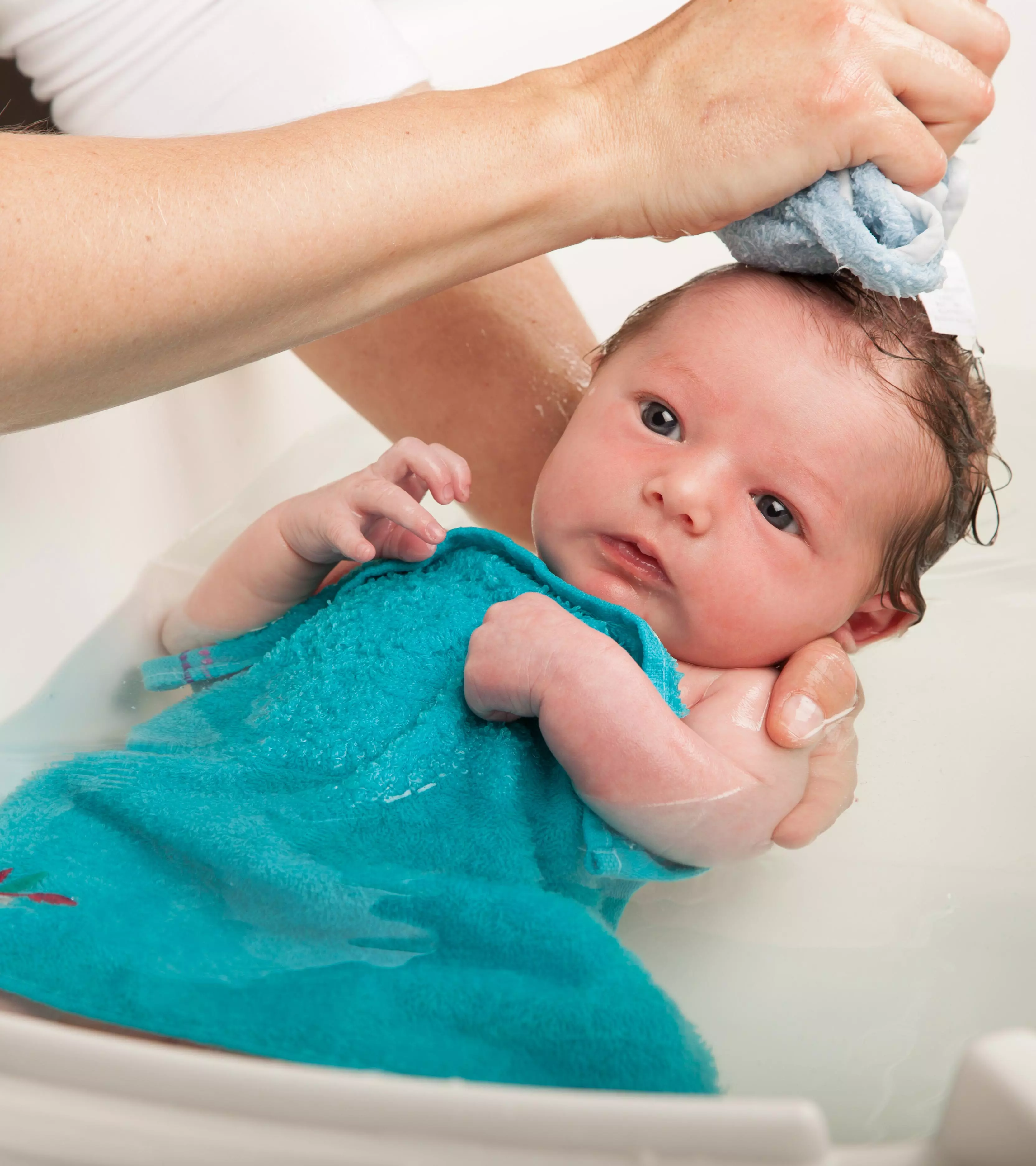
Image: Shutterstock
Hydrocortisone is a topical corticosteroid medication available in the form of lotions, ointments, and creams (1). Hydrocortisone cream for babies is an over-the-counter drug and is usually prescribed to relieve skin-related symptoms such as redness, itchiness, and swelling. However, you should use this cream only when advised by your baby’s pediatrician, as undirected use of this medication could cause side effects in babies. Explore the directions of use, recommended dosage, side effects, precautions, and other concerns regarding hydrocortisone creams for babies.

Key Pointers
- Hydrocortisone creams are prescribed to treat the skin’s swelling, itching, or redness.
- But it should be used only under the supervision of a medical practitioner to avoid unwanted repercussions.
- Instead of hydrocortisone creams, you might also use skin lotions or creams.
Is Hydrocortisone Cream Safe For Babies?
Mild doses of hydrocortisone creams used as per the doctor’s direction are unlikely to cause any side effects. The use of hydrocortisone without a doctor’s supervision may lead to undesired effects.
Possible side effects of hydrocortisone cream due to inappropriate use may include (2):
- Redness of the skin
- Possible spread of untreated infection from the affected area of skin to unaffected areas
- The skin may become thin after long-term use
- The skin may become lighter during the topical treatment
- The skin may become dry and flaky
In some rare cases, corticosteroid cream can get absorbed into the bloodstream, primarily through damaged skin (wounds), and may cause side effects. Adrenal glandiTwo glands situated above the kidneys that produce hormones, including cortisol, adrenaline, and aldosterone. suppression and high blood sugar are the side effects of steroids, and these may cause the following signs and symptoms (2).
- Stomach upset
- Vomiting
- Fainting
- Muscle weakness
- Weight loss
- Sleepiness or drowsiness
- Rapid breathing
- Fruity odor of the breath
- Loss of appetite or increased hunger
Babies and young children may have slow growth due to the absorption of hydrocortisone into the bloodstream. In rare cases, anaphylaxis (allergic reactions) may occur, which needs to be treated in an emergency.
Note: Hydrocortisone cream may not have side effects in all babies, and not all side effects may be seen in a baby.
 Experts say
Experts sayWhy Is Hydrocortisone Cream Used For Babies?
Application of hydrocortisone cream or ointment reduces swelling, erythema (redness), and pruritus (itching) caused by skin inflammation from various diseases and conditions.
Pediatricians may prescribe hydrocortisone creams for the following conditions weighing the benefits over risks (3).
- Eczema

- Contact and seborrheic dermatitis
- PsoriasisiA skin condition characterized by thick, scaly patches, dryness, and itchiness.
- Insect bites or stings
- Diaper rash in extreme cases
- Heat rash in extreme cases
 Did you know?
Did you know?You may apply the cream as directed by the doctor for positive outcomes.
How Do You Use Hydrocortisone Cream On Babies?
You may follow the following tips for the right application of hydrocortisone cream on your baby’s skin (3).
- Wash or sanitize your hands before and after applying the cream.
- Squeeze out the required amount of cream on your finger.
- Gently apply a thin layer of the cream to the affected area.
- Gently and slowly rub the cream until it disappears and absorbs into the skin.

Observing the following precautions may help avoid side effects and other adverse effects.
- Do not use the cream on unaffected skin.
- Do not use more or less than the quantity prescribed by the doctor.
- Do not cover the affected area with a bandage after application unless directed by the doctor. If applying to the diaper area, do not cover it with a tight-fitting diaper. You may dress the baby in loose clothing.
- Do not apply the cream around the mouth or eyes unless directed by the doctor.
It is best to apply the cream at the same time each day, and not use it along with other medicated creams or skin products, like moisturizers. Maintain a gap of eight to 12 hours between applications if the baby has a dosage of twice a day. If you notice no improvement in a week or if the condition worsens, speak to the doctor.
Dr. Alexandra Clark, a pediatrician at Loma Linda University Health, advises using prescribed steroid creams like hydrocortisone twice daily for up to a week to treat eczema. She recommends waiting at least an hour before applying a moisturizer to ensure the cream works effectively (8).
 Experts say
Experts sayHow Much Cream Should You Apply To Babies?
The amount of hydrocortisone cream needed may vary depending on the type of skin condition, the severity of the condition, the affected area of the body, and your baby’s age. You may follow the pediatrician or pediatric dermatologist’s prescription for the dose and duration of the topical treatment.
Pediatricians may prescribe the amount of cream in the fingertip unit, that is, the amount of cream that can be squeezed on your fingertip. Usually, one fingertip unit is recommended for a skin area double the size of the flat or palm of your hand.
Alternatives To Hydrocortisone Cream For Babies
If your baby has side effects to even low to moderate potency topical hydrocortisone, pediatricians may suggest alternatives to treat the skin condition. These may include:
- Anti-allergic medications
- Skin moisturizing creams, ointments, or lotions
- Regular baths using baby shampoos, however avoid prolonged periods in water

- Application of breast milk can be considered for diaper rash
- Regular baths using baby shampoos
 Research finds
Research findsKeeping your baby’s skin clean and dry is the best way to prevent many skin conditions, such as diaper rash and contact dermatitisiA skin condition characterized itchiness and inflammation, triggered by a particular substance or allergen.
. If your baby has sensitive skin, try to use hypoallergeniciCharacteristic of a substance to cause fewer allergic reactions. baby products and always seek advice from the pediatrician when you notice skin rash in babies. Never delay the care until more skin area is affected.
Facts About Steroid Creams
Knowing the usage, benefits, and effectiveness of topical steroid creams can ease your concerns and support informed decisions regarding your baby’s skin health. The following facts may help you to know more about the topical hydrocortisone medications (2).
- Hydrocortisone belongs to the class of medicines called corticosteroidsiSteroid hormones produced in the adrenal cortex that help alleviate inflammation and the immune system activity. , which is different from anabolic steroids used for muscle enhancement.
- Most hydrocortisone creams are mild.
- Hydrocortisone butyrate (Locoid) is a potent medication that is only available on prescription.
 Quick fact
Quick fact- Hydrocortisone creams are available in different dosage forms such as 0.1%, 0.5%, 1%, 2.5%, etc. 0.1% hydrocortisone cream contains 1mg hydrocortisone in each gram of cream, while 2.5 % hydrocortisone cream contains 2.5mg of hydrocortisone in each gram.

- Hydrocortisone creams plus antimicrobials (antifungal or antibacterial) are often available for treating skin inflammation due to skin infections.
- Topical corticosteroids like hydrocortisone exert their therapeutic effects through anti-inflammatory, antiproliferative, immunosuppressive, and vasoconstrictive mechanisms (9).
- Ointments are preferred for dry and flaky skin conditions, and lotions help cover large areas of skin and scalp. The cream form is best recommended for moist skin areas.
Frequently Asked Questions
1. When will the hydrocortisone cream start showing results?
You may see results in three to seven days after commencing application. Even though the baby’s skin inflammation gets better, apply the cream for as long as directed by the doctor. If the baby’s condition worsens or there is no improvement after a week of use, contact your pediatric dermatology specialist (3).
2. What will happen if I forget to apply the hydrocortisone cream?
It is normal to miss a dose of medication during your busy schedule. If you forget to apply the ointment or cream on a prescribed time, you may follow the below recommendations to avoid excess use (3).
- If you apply only once a day in the evening or morning, you may use the cream as soon as you remember. You need to maintain a minimum of eight hours between the applications.
- If you miss a twice-a-day dose, you may apply until there is a minimum four-hour gap between the next dose. If not, skip the missed dose and continue with the regular dose.
Never bother a sleeping baby to apply a missed dose of ointment or cream. You may do it when they wake up, or if there is not enough time gap, continue with regular dosage timings.
3. What will happen if I apply hydrocortisone cream in excess?
A little more than the normal dosage may not harm your baby’s skin. However, do not consistently apply more than the prescribed quantity. Seek medical help if the baby has skin irritation or any other reactions.
4. Can other creams be applied along with the hydrocortisone?
You should not apply other creams, lotions, or ointments at the same time with hydrocortisone. Wait at least ten minutes after the application of hydrocortisone to apply your baby’s moisturizers or emollientiA substance that helps soothe and moisturize the skin, often employed to manage skin conditions that cause dryness or irritation. . It is ideal to apply different products at different times to avoid cross-reactions (3).
There is no restriction on the intake of paracetamol or ibuprofen along with topical hydrocortisone application unless restricted by the pediatrician. You may check with the pharmacists or doctors before taking any other medications, including herbal and complementary products, with hydrocortisone.
5. Does hydrocortisone cream help treat diaper rash?
Mild hydrocortisone creams can be used to treat a baby’s diaper rash. However, keeping the skin clean and dry is the best way to avoid diaper rash in babies (4). You may seek help from a pediatrician to identify if your baby has a fungal or bacterial skin infection in the diaper area. In such cases, oral antibiotics, topical antibiotics, or antifungal creams could be needed.
6. Can I put hydrocortisone on my baby’s face?
The NHS recommends that you refrain from using hydrocortisone on your baby’s face unless specified by a healthcare professional. Furthermore, unwarranted use of these topical medications may aggravate skin problems in children (5).
7. Can hydrocortisone burn baby skin?
Unprescribed, long-term use of topical steroids, such as hydrocortisone, may lead to severe reactions, including skin peeling and burning sensations (6).
8. What if my baby accidentally ingests hydrocortisone cream?
If your baby swallows hydrocortisone cream, gently wipe their mouth with a damp cloth, give them a little water, and avoid forcing them to vomit. While a small amount may not be harmful, it’s important to call a doctor or poison control immediately, as treatment may vary depending on the amount of substance ingested (12).
Pediatricians may prescribe hydrocortisone cream for your baby to reduce signs of skin inflammation such as redness and swelling due to skin infections or other diseases. The amount of cream may vary depending on the skin conditions. It is recommended to use OTC hydrocortisone cream as per the doctor’s advice since it can be associated with side effects. You should wash your hands before applying the cream layer to the affected area. Also, ensure not to apply the cream on unaffected areas of skin.
Infographic: Home Remedies For Itchy Skin In Babies
Parents are often concerned about the use of ointments for their babies. Although they can be safely used when prescribed by a doctor, some may want to explore natural alternatives. Here is an infographic that helps you on this matter by providing natural solutions to manage your baby’s itchy skin.
Some thing wrong with infographic shortcode. please verify shortcode syntax
Wondering if hydrocortisone cream is safe on the dry skin of your 8-week-old baby? Explore this video to find out about the advantages and risks associated with it.
References
1. Hydrocortisone Topical; U.S. National Library of Medicine
2. Hydrocortisone skin creams; National Health Service
3. Pregnancy with Influenza Vaccination During Pregnancy.
4. Nappy Rash; All Wales Medicines Strategy Group; National Health Service
5. Hydrocortisone for skin; NHS.
6. Hydrocortisone skin cream, ointment, lotion, or solution; Cleveland Clinic
7. Burns: Symptom Management; University of Rochester Medical Center
8. Pediatrician breaks down infant eczema and how best to combat it; Loma Linda University Health
9. Corticosteroids for Atopic Dermatitis; American Academy of Pediatrics.
10. Hydrocortisone for Itching; Children’s Hospital at Montefiore Einstein
11. Leila Amiri Farahani et al., (2013);Comparison of the effect of human milk and topical hydrocortisone 1% on diaper dermatitis; Pediatric Dermatology
12. Topical Steroids; Missouri Poison Center
Community Experiences
Join the conversation and become a part of our nurturing community! Share your stories, experiences, and insights to connect with fellow parents.
Read full bio of Dr. Elna Gibson
Read full bio of Dr Bisny T. Joseph
Read full bio of Rohit Garoo
Read full bio of Vidya Tadapatri
















